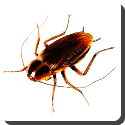 Cockroaches — Cockroaches (or simply “roaches”) are insects of the order Blattodea. This name derives from the Latin word for “cockroach”, blatta.
Cockroaches — Cockroaches (or simply “roaches”) are insects of the order Blattodea. This name derives from the Latin word for “cockroach”, blatta.
Among the most well-known species are the American cockroach, Periplaneta americana, which is about 3 cm long, the German cockroach, Blattella germanica, about 1½ cm long, the Asian cockroach, Blattella asahinai, also about 1½ cm in length, and the Oriental cockroach, Blatta orientalis, about 2½ cm. Tropical cockroaches are often much bigger, and extinct cockroach relatives such as the Carboniferous Archimylacris and the Permian Apthoroblattina were several times as large as these. Cockroaches are generally considered pests; however, only about 30 species (less than 1%) infest urban habitats.
The earliest cockroach-like fossils are from the Carboniferous period between 354–295 million years ago. However, these fossils differ from modern cockroaches in having long ovipositors and are the ancestors of mantids as well as modern cockroaches. The first fossils of modern cockroaches with internal ovipositors appear in the early Cretaceous.
Mantodea, Isoptera, and Blattodea are usually combined by entomologists into a higher group called Dictyoptera. Current evidence strongly suggests that termites have evolved directly from true cockroaches. If this is the case, then Blattodea excluding Isoptera is not a monophyletic group and the Isoptera are actually a family (or epifamily) of cockroaches.
Cockroaches have been shown to exhibit emergent behaviour.
Research being conducted at the University of Florida shows that cockroaches leave chemical trails in their feces. Other cockroaches will follow these trails to discover sources of food and water, and also discover where other cockroaches are hiding. One of the major implications of this research is a new technique in cockroach pest control. Cockroaches could potentially be removed from a home by leaving a chemical trail that leads away from the home.
Research has shown that group-based decision making is responsible for more complex behavior such as resource allocation. A study where 50 cockroaches were placed in a dish with three shelters with a capacity for 40 insects in each, the insects arranged themselves in two shelters with 25 insects in each, leaving the third shelter empty. When the capacity of the shelters was increased to more than 50 insects per shelter, all of the cockroaches arranged themselves in one shelter. Researchers found a balance between cooperation and competition exists in group decision-making behavior found in cockroaches. The models used in this research can also explain the group dynamics of other insects and animals.
Another study tested the hypothesis that cockroaches use just two pieces of information to decide where to go under those conditions: how dark it is and how many of their friends are there. The study conducted by José Halloy and colleagues at the Free University of Brussels and other European institutions created a set of tiny robots that to the roaches appear to be other roaches and can thus alter the roaches perception of critical mass.
Additionally, researchers at Tohoku University engaged in a Classical Conditioning experiment with cockroaches and discovered that the insects were able to associate the scent of vanilla and peppermint with a sugar treat.
A 2005 US national study on factors that affect asthma in inner-city children shows that cockroach allergens appear to worsen asthma symptoms more than other known triggers. This study, funded by the US National Institute of Environmental Health Sciences (NIEHS) and the US National Institute of Allergy and Infectious Diseases (NIAID), is the first large-scale study to rank asthma triggers according to severity.
Cockroaches live in a wide range of environments around the world. Pest species of cockroaches adapt readily to a variety of environments, but prefer warm conditions such as found within buildings. Many tropical species prefer even warmer environments and do not fare well in the average household. Only about 20 species of cockroaches out of the 3,500 are suited to thrive in the typical home.
 Kids Portal For Parents India Kids Network
Kids Portal For Parents India Kids Network
